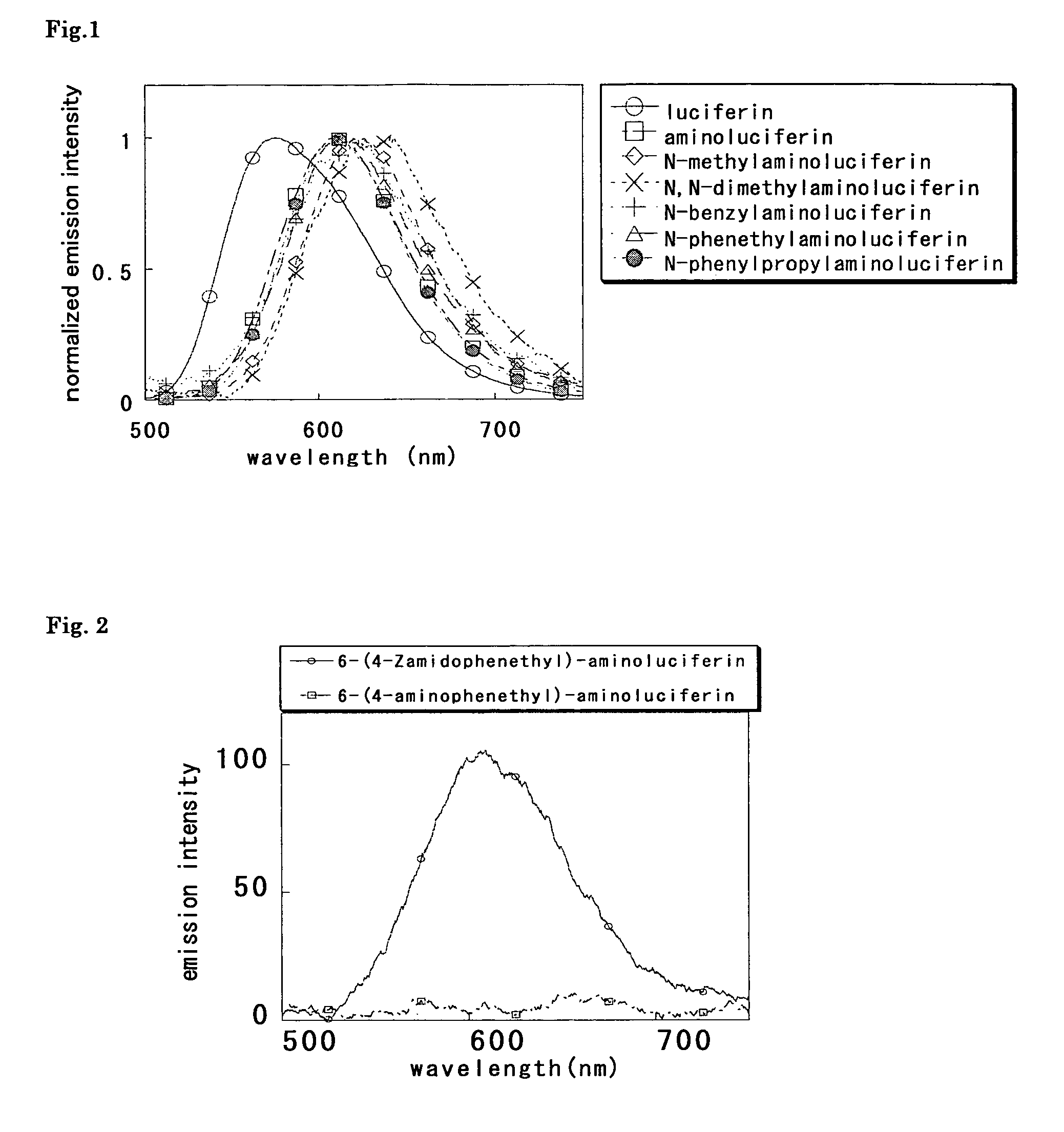Luciferin derivatives
a technology of luciferin and derivatives, applied in the field of luciferin derivatives, can solve the problems of no report whose approach is to modify luciferin, inability to use in in vivo imaging, and inability to achieve the effect of modifying luciferin,
- Summary
- Abstract
- Description
- Claims
- Application Information
AI Technical Summary
Problems solved by technology
Method used
Image
Examples
example 1
Synthesis of Aminoluciferin derivatives 10 to 14
[0037]The synthetic scheme of Compounds 10 to 14 is shown below.
[0038]
(A) Synthesis of 2-chloro-6-nitrobenzothiazole (2)
[0039]Compound 1 (25.1 g, 147 mmol) was added dropwise to concentrated sulfuric acid (135 mL) under ice cooling, then potassium nitrate (16.4 g, 162 mmol) was added to the mixture. The mixture was stirred under ice cooling as it was for 30 minutes, and then stirred at room temperature for 1 hour. The reaction mixture was poured into ice water, and the precipitates were separated by filtration and washed with water. The precipitates were recrystallized from ethanol to obtain Compound 2 as white acicular crystals (15.6 g, 49% yield).
[0040]1H-NMR (300 MHz, CDCl3) δ 8.07 (d, 1H, J=8.9 Hz), 8.39 (dd, 1H, J=2.2, 8.9 Hz) 8.75 (d, 1H, J=2.2 Hz). MS (EI+) 214, M+.
(B) Synthesis of 2-chloro-6-aminobenzothiazole (3)
[0041]Compound 2 (1.96 g, 9.14 mmol) was dissolved in ethanol (150 mL) and purified water (100 mL), and the solution...
example 2
Measurement of luminescence spectra of luciferin, aminoluciferin and Compounds 10 to 14
[0078]Luminescence spectra of luciferin, aminoluciferin and Compounds 10 to 14 were measured. To measure luminescence spectra, agents were dissolved in 30 mmol / L N-2-hydroxyethylpiperazine-N′-2-ethanesulfonic acid (HEPES) buffer (pH 7.7) so that the solution contained 5 mmol / L magnesium sulfate, 2.6 mmol / L adenosine triphosphate (ATP), 3.5 mmol / L dithiothreitol (DTT), 1.5 mmol / L coenzyme A (CoA) and 20 or 40 μg / mL luciferase (firefly, 20 μg / mL for luciferin, 40 μg / mL for aminoluciferin and Compounds 10 to 14), and finally to the solution was added each luciferin (containing 0.2% DMSO as cosolvent (except for luciferin)) at a final concentration of 6 or 12 μmol / L (6 μmol / L of luciferin, 12 μmol / L of aminoluciferin and Compounds 10 to 14). Spectra were standardized on the basis of the peak top of each luciferin. The measurement was performed by using Fluorescence Spectrophotometer F-4500 (Hitachi). ...
example 3
Luminescence characteristics of luciferin, aminoluciferin and Compounds 10 to 14
[0079]Luminescence characteristics of luciferin, aminoluciferin and Compounds 10 to 14 were evaluated. To measure luminescence, agents were dissolved in 30 mmol / L HEPES buffer (pH 7.7) so that the solution contained 5 mmol / L magnesium sulfate, 2.6 mmol / L ATP, 3.5 mmol / L DTT, 1.5 mmol / L CoA and 20 μg / mL luciferase (firefly), and to the solution was finally added each luciferin (containing 0.2% DMSO as a cosolvent (except for luciferin)) at a final concentration of 12 μmol / L. Relative intensity was calculated on the basis of the intensity obtained for aminoluciferin. The measurement was performed by using Fluorescence Spectrophotometer F-4500 (Hitachi). The results are shown in Table 1.
[0080]
TABLE 1initialrelativeλmax(nm)intensityintensityluciferin5757332aminoluciferin6092044100.0N-methylaminoluciferin624136066.5N,N-dimethylaminoluciferin64190144.1N-benzylaminoluciferin6231065.2N-phenethylaminoluciferin611...
PUM
| Property | Measurement | Unit |
|---|---|---|
| emission wavelength | aaaaa | aaaaa |
| emission wavelength | aaaaa | aaaaa |
| wavelength | aaaaa | aaaaa |
Abstract
Description
Claims
Application Information
 Login to View More
Login to View More - R&D
- Intellectual Property
- Life Sciences
- Materials
- Tech Scout
- Unparalleled Data Quality
- Higher Quality Content
- 60% Fewer Hallucinations
Browse by: Latest US Patents, China's latest patents, Technical Efficacy Thesaurus, Application Domain, Technology Topic, Popular Technical Reports.
© 2025 PatSnap. All rights reserved.Legal|Privacy policy|Modern Slavery Act Transparency Statement|Sitemap|About US| Contact US: help@patsnap.com



